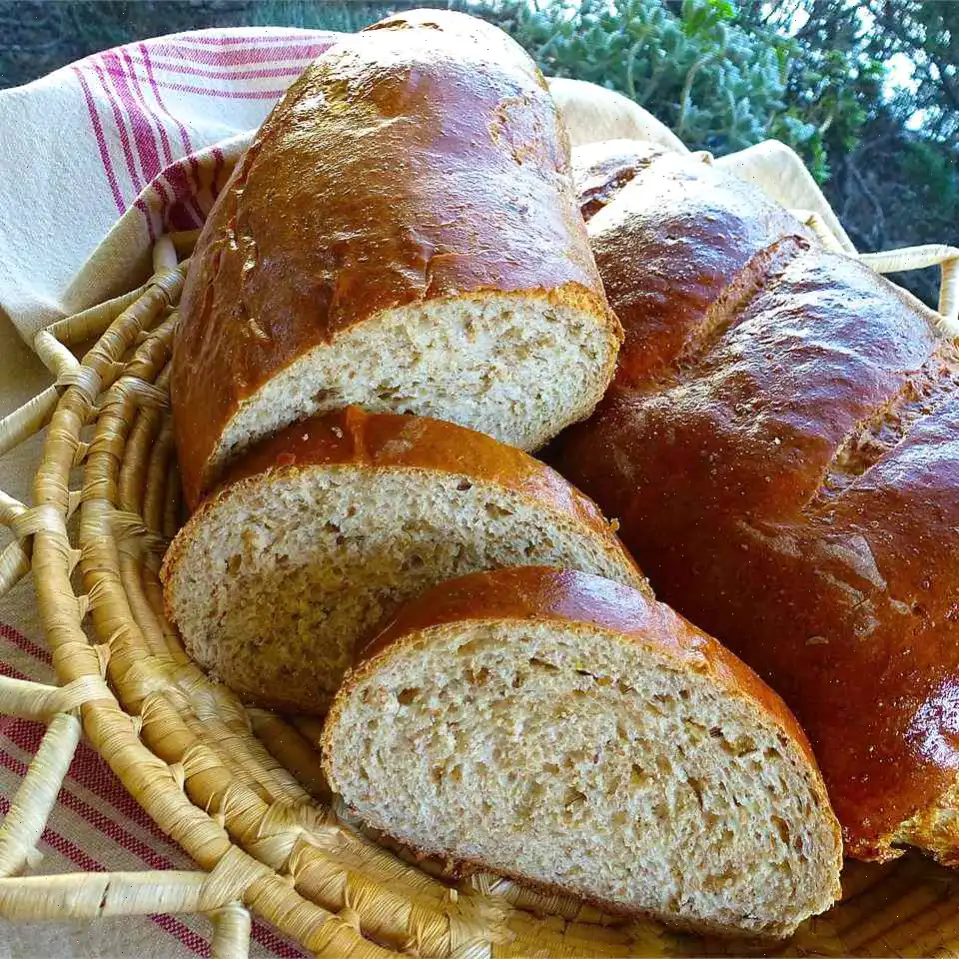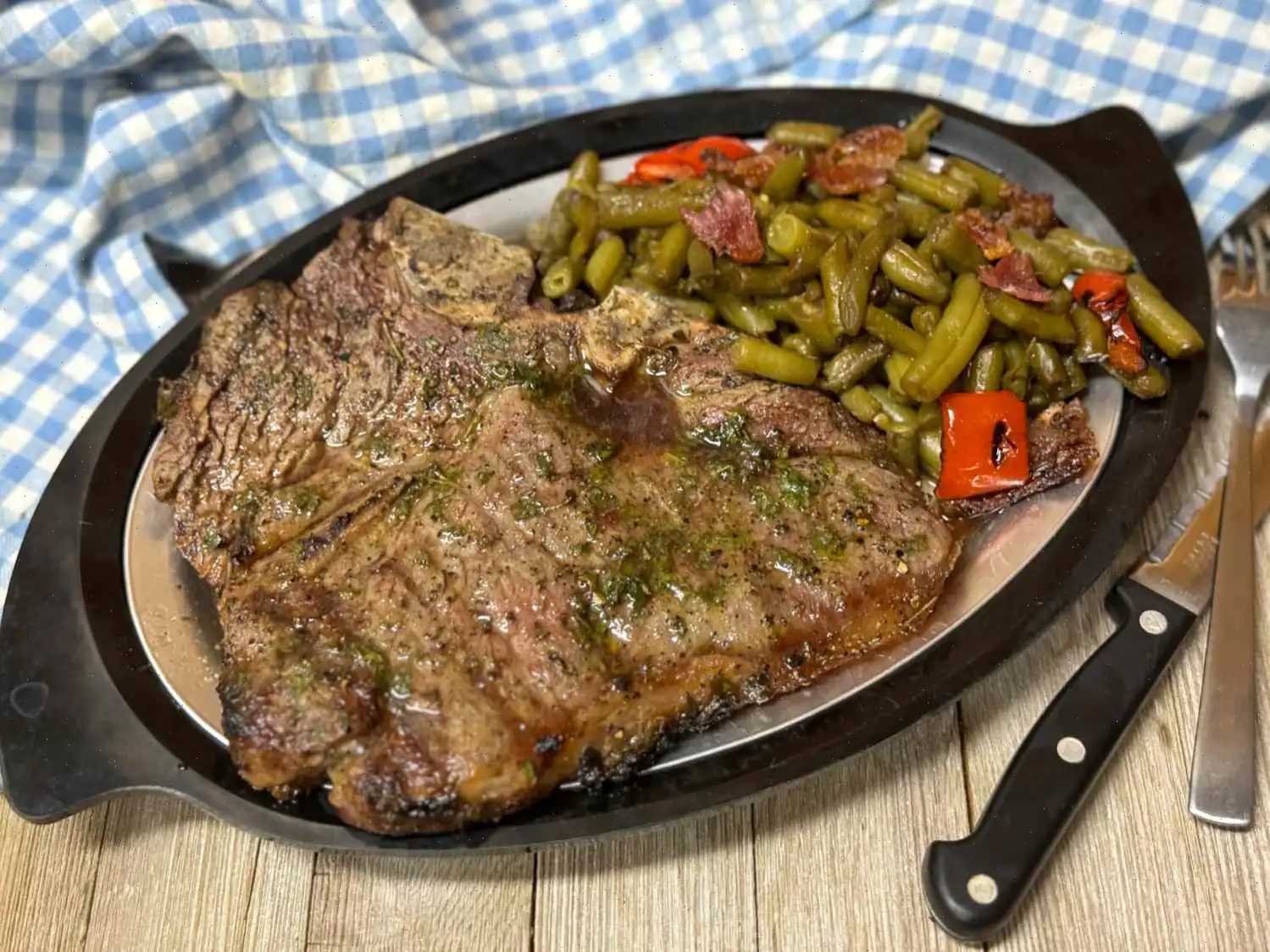
Rye Beer Bread Recipe
Ingredients
- 2 cups rye flour
- 1 cups room temperature beer
- 2 (.25 ounce) packages active dry yeast
- 2 tablespoons white sugar
- 1 tablespoon salt
- 2 tablespoons shortening
- 1 egg
- 3 cups bread flour
- 1 tablespoon caraway seed (Optional)
- 1 tablespoon cornmeal
Directions
Step 1: In a large bowl, combine rye flour, beer, and yeast. Cover the bowl with plastic wrap and set it aside overnight at room temperature. Do not refrigerate.
Step 2: The following day, add sugar, salt, shortening, and egg to the mixture. Use a mixer to beat until the mixture is smooth and well combined.
Step 3: Stir in caraway seeds if desired. Gradually add enough bread flour to form a soft dough.
Step 4: Knead the dough on a lightly floured surface for about 10 minutes, until it becomes smooth and elastic.
Step 5: Place the dough in a greased bowl, turning the dough to coat the surface with oil. Cover and let it rise in a warm place for about 1 hour, or until the dough has doubled in size.
Step 6: Once the dough has risen, punch it down to release the air. Divide the dough in half and shape each half into either a round or oblong loaf.
Step 7: Place the shaped loaves on greased baking sheets that have been lightly sprinkled with cornmeal. Allow the loaves to rise for an additional 30 minutes.
Step 8: Preheat the oven to 400F (205C). Bake the loaves for 30 minutes, or until golden brown and fully cooked through.
Step 9: Remove the bread from the oven and allow it to cool on wire racks before serving.
Nutrition Facts
Serving Size: 1 slice (1/24 of recipe)
- Calories: 120
- Total Fat: 2g (2% Daily Value)
- Saturated Fat: 0g (2% Daily Value)
- Cholesterol: 8mg (3% Daily Value)
- Sodium: 295mg (13% Daily Value)
- Total Carbohydrate: 22g (8% Daily Value)
- Dietary Fiber: 2g (7% Daily Value)
- Total Sugars: 1g
- Protein: 3g (7% Daily Value)
- Calcium: 9mg (1% Daily Value)
- Iron: 1mg (6% Daily Value)
- Potassium: 60mg (1% Daily Value)
* Percent Daily Values are based on a 2,000 calorie diet. Your daily values may vary based on your individual calorie needs.
Rye Beer Bread is a hearty, flavorful bread that combines the richness of rye flour with the boldness of beer. The incorporation of beer adds a unique depth to the flavor profile, making it a popular choice for those who appreciate the tanginess of rye and the robustness of beer. This bread is versatile, perfect for sandwiches, as a side dish, or simply toasted with butter.
History of Rye Beer Bread
Rye Beer Bread has its roots in the ancient baking traditions of Europe, particularly in regions where rye flour was more common than wheat. Rye itself has been cultivated for thousands of years, particularly in cooler climates, where it thrives better than wheat. The introduction of beer into bread recipes is believed to date back to at least the Middle Ages when beer was a staple in many European households. The use of beer in bread making is thought to have begun in the beer-brewing regions of Germany, where beer was a readily available ingredient. Over time, this unique combination spread, with regional variations, to other parts of the world.
Regional Features
Rye Beer Bread is most commonly associated with Northern and Eastern Europe, particularly in Germany, Scandinavia, and the Baltic countries, where rye flour is a key ingredient in traditional baking. In Germany, this bread is often referred to as "Bierbrot" and is served with hearty meals like sausages, meats, and cheeses. Scandinavian countries, where rye bread is a dietary staple, also have their own variations, with beer sometimes added to enhance flavor and texture. The American version of Rye Beer Bread, popular in many households today, is typically lighter and sweeter, often incorporating ingredients like molasses or honey and using various types of beer for different flavor profiles.
Differences from Similar Dishes
Rye Beer Bread is often compared to traditional rye bread and other beer breads, but it stands out in a few ways. Unlike most rye breads, which can be dense and slightly sour due to the use of sourdough starter, Rye Beer Bread is typically lighter and softer, thanks to the yeast fermentation and the addition of beer. The beer provides both flavor and moisture, which is absent in standard rye breads. This makes the bread slightly sweeter and less chewy than traditional rye breads. It also contrasts with other beer breads, such as those made with white or whole wheat flour, in that it maintains the characteristic dark color and nutty flavor of rye. The addition of caraway seeds further distinguishes it from other beer breads, adding a distinctive spice that is commonly associated with rye.
Where It Is Typically Served
Rye Beer Bread is a versatile bread that can be enjoyed in a variety of settings. In Europe, it is commonly served with hearty meals, particularly with meats, sausages, and cheeses. It pairs well with German beer and is often included in a traditional German or Scandinavian meal. In the United States, it is popular as a side dish for soups, stews, or chili. It is also a favorite for making sandwiches, particularly those with strong-flavored fillings like ham, corned beef, or cheese. Rye Beer Breads rich flavor profile makes it an excellent choice for casual gatherings or more formal dinner parties.
Interesting Facts
- In some recipes, the beer used in Rye Beer Bread can be swapped for stout or porter, adding even more depth to the breads flavor. Dark beers are often preferred as they complement the earthy tones of the rye.
- The use of beer in baking is not just for flavor; beer also helps in the leavening process, adding to the texture and lightness of the bread. The yeast in beer can be used as a natural leavening agent, much like the yeast used in traditional bread-making.
- Caraway seeds, a common addition to Rye Beer Bread, have been used for centuries, both for their distinctive flavor and their medicinal properties. They are known to aid digestion and are frequently included in many traditional rye bread recipes.
- Rye Beer Bread has become increasingly popular among craft beer enthusiasts who enjoy experimenting with different types of beer to create unique bread flavors. Many bakers now use seasonal or locally brewed craft beers to give their loaves a personal touch.
FAQ about Rye Beer Bread Recipe
Comments
Andrew Hernandez
06/16/2024 01:31:36 PM
When strictly adhered to, this recipe yields an exceptionally delicious rye bread loaf. In my previous review, I highlighted the significance of the beer type used and its impact on the final flavor profile. After multiple attempts, I have fine-tuned the recipe to create my favorite version: 1. Opt for a rich, locally brewed coffee stout for a deep flavor. 2. Enhance the rise by incorporating 1 tablespoon of vital wheat gluten into the bread flour. 3. Increase the amount of caraway seeds to 2 tablespoons for a more pronounced flavor. 4. Achieve a crunchy crust by placing a tray of water in the oven during baking. 5. Brush the loaves with an egg white and water mixture for a glossy finish in the last ten minutes of baking.
Dorothy Thompson
06/01/2024 08:46:07 AM
I made this recipe recently and it received enthusiastic praise from my family! I substituted brown sugar for white sugar and decided to use Guinness since I had it at home. I utilized my bread machine for the entire process. I will definitely be making this again. It pairs wonderfully with corned beef. The bread turned out quite dense, yet somehow light and moist at the same time. Thank you for sharing this wonderful recipe!
Jennifer Hall
04/08/2023 02:08:53 AM
Here is my rewritten version of the review: I absolutely loved trying out this recipe! I decided to use a rich dark oatmeal stout and added a tablespoon of molasses to the rest of the sponge ingredients, allowing it to sit overnight. For the rising process, I preheated my oven to 200°F and then turned it off before placing the bread in the oven, loosely covered with parchment paper, until it doubled in size. I divided the dough into two bread pans before baking. Prior to baking, I made slashes on the top of the loaves with a sharp knife to help the bread rise better. The end result was a deliciously chewy, flavorful bread with a hint of beer and a lovely yeasty taste – simply awesome!
Susan Gonzalez
12/02/2022 03:32:27 AM
This recipe is fantastic! Thank you for sharing it. The texture turned out wonderfully, and the bread stayed fresh in the fridge for days. It sliced perfectly thin for toast or rye crisp. Paired with herbed cream cheese, it made for a heavenly rye bread breakfast. I just finished the last slice, and I'm already planning to start another batch today. I baked two long loaves using IPA and a corn starch glaze. Next time, I'll slightly reduce the baking time as my previous loaves ended up a little overdone.
Kathleen Campbell
07/15/2024 03:41:17 AM
Rewritten review: Over the past 5 years, I've tested approximately 20 different rye bread recipes, all of which left me disappointed. When I stumbled upon this particular recipe, I didn't hold high expectations, but the positive feedback from others gave me hope. I followed the recipe closely, with a few minor adjustments like using 1 tablespoon of sugar and 1 tablespoon of molasses, and opting for a Honey Lager (though I plan to try a stout next time). And let me just say, thank you! Finally, a rye bread that exceeded my expectations! The dough was soft and easy to work with after the first rising of about 2 hours, followed by a second rise of approximately 90 minutes. I ended up using only about 2 1/3 cups of white bread flour. I pulled the bread out of the oven at 2:00 pm, and by 7:30 pm, only 1/4 of it remained. It was truly awesome. You won't be disappointed. Update: A week later, I decided to make it again, this time using Alexander Keiths Red Amber. The result? Absolutely delicious!
Dorothy Thompson
09/17/2024 02:38:43 PM
The first batch was a bit too salty for us. I adjusted the recipe to use 1 teaspoon of salt instead of 1 tablespoon, and it turned out just right. This recipe is definitely going on my list of favorites. It's so easy to make, moist, and has a wonderful flavor.
Kevin Wright
07/25/2024 03:37:29 AM
Here is the revised version of the review: "I absolutely loved this recipe. It's easy to follow and has a wonderful flavor. I tried baking one loaf on a sheet in an electric oven and the other in a crockpot in a gas oven. Personally, I preferred the electric oven results. One tip I have is to avoid using table salt in this recipe - I recommend using kosher or sea salt instead, or reducing the amount of salt called for."
Diane Smith
11/07/2023 04:44:09 AM
I absolutely adore this recipe! I have experimented with various IPAs and lagers, resulting in unique and delightful flavors.
Jeffrey Parker
01/15/2024 09:30:30 AM
I have checked the internal temperature with a thermometer and it is cooling down. I enjoy letting it ferment overnight. I appreciate dividing the work into smaller tasks. I will potentially provide an update after tasting. Before baking, I brushed it with beaten egg and sprinkled everything bagel seasoning on top.
Dennis Edwards
07/22/2024 03:17:30 PM
No changes. Not my top choice.
Susan Jones
04/25/2024 11:19:55 PM
I absolutely adored the taste of this bread! The only tweak I made was baking it on a baking stone rather than a cookie sheet. However, I was a bit let down when the bread cracked along the side during baking. I wonder if scoring "relief" lines on the top before baking would prevent this issue?








